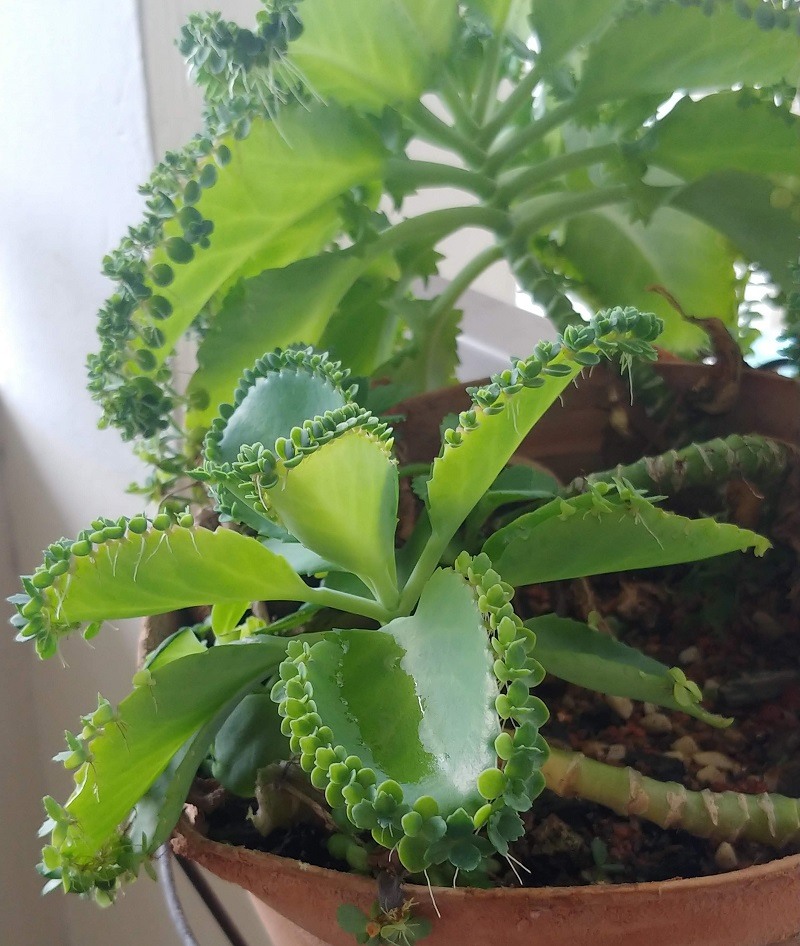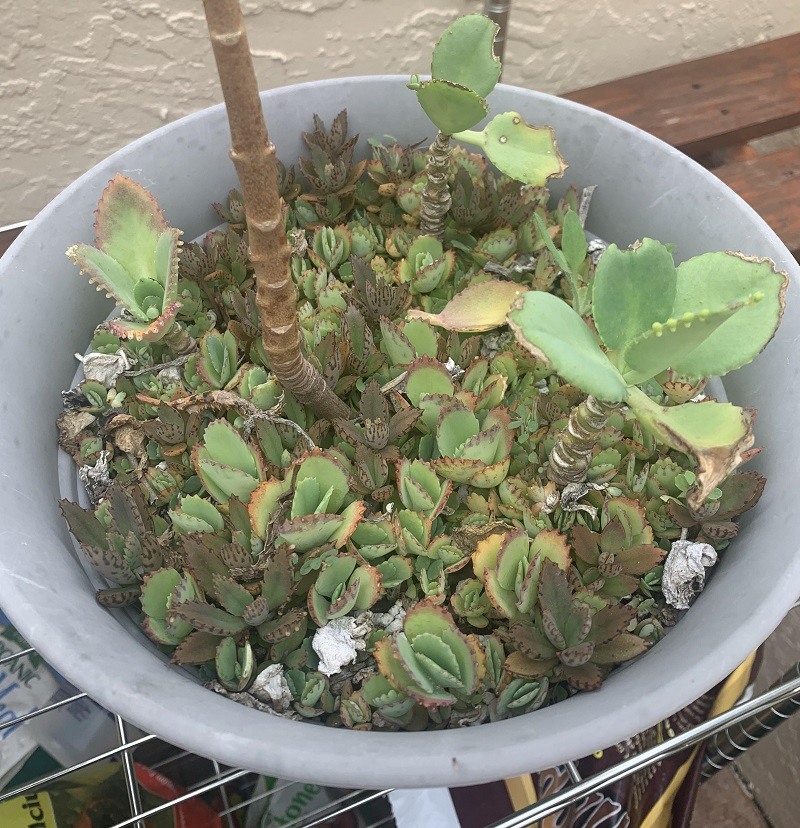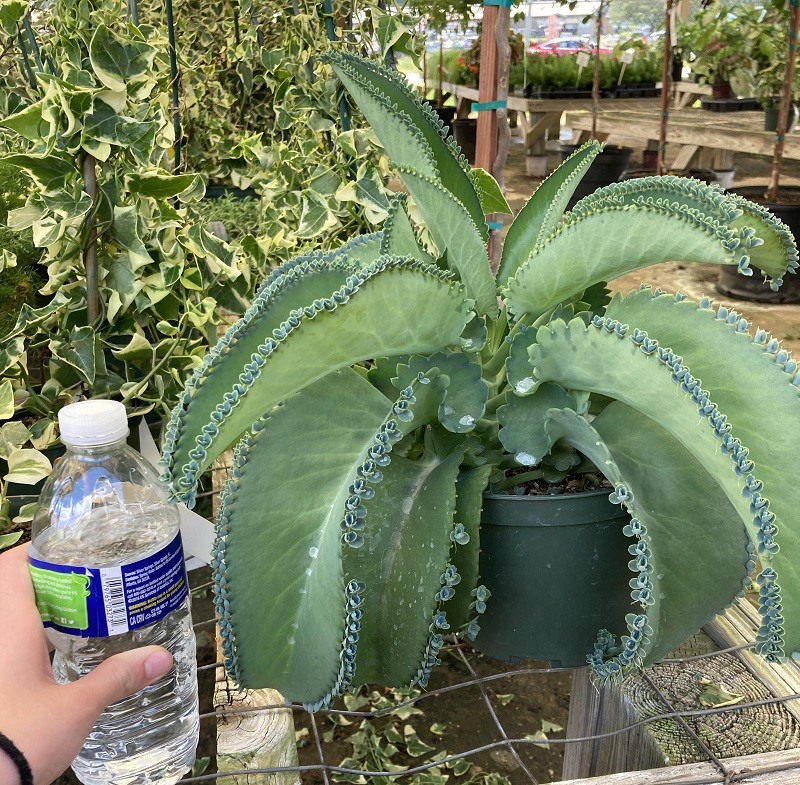Mother of thousands (kalanchoe daigremontiana) is my favorite indoor succulent plant. Thanks to its attractive foliages with plantlets along the edges and tips. If you have a mother of thousands plant, it would be best to learn how to care for it.
How to care for a mother of thousands involves the provision of well-draining soil, bright indirect sunlight, a temperature range of 65-75oF, low humidity, and an infrequent watering routine. Mother of thousands succulent is forgiving and low-maintenance.
Keep reading this guide to learn how to care for a mother of thousands plant like a professional. You’ll also appreciate everything about mother of thousands propagation and problems affecting it with their respective solutions.
You May Also Like: How to Care for Begonia Maculata

What Do Mother of Thousands Look Like?
The mother of thousands succulents belongs to the Crassulaceae family. The succulent species is related to the jade plant and flaming Katy. The succulent plant is native to Madagascar and is also known as the Mexican hat plant.
The stunning foliages with plantlets at the tips are one of the reasons behind the high demand in the market. The mother of 1000 plants rarely blooms when grown indoors. The houseplant can grow from a single stem.
The narrow and large blue-green leaves grow up to six inches long. Besides that, these foliages are pointed and three inches wide. The alligator plant grows up to 18-35 inches with ultimate care. The tiny plantlets make propagation look easier than other houseplants.
Mother of thousands plant is more invasive, and plant owners need to use growing containers properly to control it. Otherwise, this succulent with baby plants on leaves might be overwhelming for beginners.
The alligator tongue plant is hardy, drought-tolerant, and can handle intense heat without becoming fussy. The succulent plant cannot thrive in temperate and cold regions. Mexican hat plant care is super simple if you follow the tips highlighted in this guide.
Mother of Thousands Care Details
| Origin | Madagascar |
| Family | Crassulaceae |
| Scientific Name | Kalanchoe daigremontiana |
| Common Names | Mother of Thousands Devil’s Backbone Mexican Hat Alligator Plant |
| Plant Type | Succulent |
| Maximum Growth (Approx.) | 3 ft Tall |
| Sunlight Requirement | Bright Indirect Sunlight |
| Soil Requirement | Slightly acidic and well-draining. |
| Temperature Range | 65-75oF |
| Watering Needs | Moderate soil moisture |
| Humidity Requirement | Low humidity level |
| Fertilizer Application | Once in a year |
| Bloom Time | Winter |
| Flower Color | Grayish-pink |
| Hardiness Zone | 9 to 11 USDA |
| Toxicity | Poisonous to cats, dogs and humans |
How to Care for Mother of Thousands
Best Soil for Growing Mother of Thousands
The alligator plant thrives in sandy soil with a well-draining feature. If you are growing this Mexican hat plant indoors, consider potting medium meant for cacti.
Mix an equal amount of perlite, pumice, and vermiculite in a regular container. These are the best alternatives for those houseplant enthusiasts lacking access to sandy soil.
Avoid potting soil with peat moss, humus, and loam textures. These mixtures will make the soil hold too much moisture that might ruin your favorite succulent plant.
Appropriate Pot for Planting Mother of Thousands
The Mexican hat roots are super delicate and need adequate air circulation. The houseplant enthusiasts need a pot with drainage holes at the bottom to drain out excess water.
These holes also help to enhance proper air circulation around the root systems of the plant. I recommend terracotta pot (Check Best Deals on Amazon) for growing the alligator plant.
Consider growing the Mexican hat plant in a smaller pot to enhance the bushier appearance and compact shape. Repot the plant once it has overgrown the current pot.
This succulent species is not ideal for sharing a pot with other plants due to the growing plantlets covering adequate space. Identify a better space for growing your alligator plant.
You May Also Enjoy: How to Care for Alocasia Black Velvet
How Often Should You Water Mother of Thousands?
Mother of thousands does not thrive in a damp environment. An infrequently watering routine is the best option when growing and caring for the Mexican hat plant.
Be sure to check the soil moisture content before watering. If the top two inches of the potting soil is dry, consider soaking it with distilled or rainwater.
Ensure the water is room temperature since the root systems are super sensitive to cold or heat. It might shock the roots and cause severe damages.
Besides that, consider watering the soil only and not the plant leaves. Too wet foliages are prone to rotting and attraction of pests.
Water the houseplant once or twice a month during the winter season. The intention is to allow the soil to dry out due to the low evaporation rate.

How Much Sun Does a Mother of Thousands Need?
The devil’s backbone loves natural sunlight to thrive. Place your succulent plant under bright indirect sunlight in hot summer to avoid scorching the leaves.
You can relocate the Mexican hat plant to direct sunlight in cold fall and early spring. It allows the plant to trap more light for carrying out its physiological activities.
Your mother of thousands will thrive in an east-facing window rather than a north-facing window. It usually receives adequate light throughout the seasons except for winter.
Another alternative is to take your succulent to direct sunlight during the early hours of the morning in hot summer. The sunlight intensity is not strong to damage and sunburn the leaves.
Avoid south and west-facing windows in early June and late September. The heat is too much and can make your houseplant droop or become limp.
If your mother of thousands has vivid green and striking red outlines, it is receiving adequate sunlight. Low light makes the plant leggy, spindly, and tall.
Right Temperature for Mother of Thousands
Mother of thousands prefers a temperature range of 65-75oF. Too high and low temperatures might ruin the growth and health of the houseplant.
Keep the plant away from cold and heat drafts to protect their foliages. I recommend using a digital thermometer (Check Best Prices on Amazon) to monitor indoor temperatures in winter.
Best Humidity for Mother of Thousands Care
The alligator plant is hardy and tolerant to various humidity levels. The indoor plant can survive best under normal room temperature without becoming fussy.
Avoid misting the leaves when the air around the plant is dry. It will help to prevent foliage damages from fungal infections.
You May Also Like: 20 Beautiful Hoya Varieties With Pictures
Fertilizer for Healthy Mother of Thousands Growth
Mother of thousands is not a heavy-feeder and does not need fertilizer application. But the nutrients from fertilizer will help to bring out a stunning appearance.
Be sure to use a dilute balanced fertilizer once every growing season. Consider fertilizer (Check Best Deals on Amazon) intended for cacti plants.
Mother of Thousands Pruning
The Mexican hat plant does not have any pruning requirements. But the removal of dead stalks and dropped plantlets help to keep the houseplant tidy.
I recommend pinching the top of the plant directly above the large leaf if it starts to be wiry and spindly. The technique will prompt the leaves to start growing further down the stem.
How to Repot Mother of Thousands
Mother of thousands is a slow-growing houseplant, but it can overgrow the pot. Consider repotting to create room or space for adequate growth.
An overgrown mother of thousands does experience roots growing through the pot drainage holes. The rootbound issue can also cause stunted growth and other damages to the plant.
Unpot the plant gently from the current pot and transplant it into a bigger container with fresh potting soil. Be sure to loosen the roots to create space for the brand new potting media.
Water the plant and provide ultimate care. The transplant shock might slightly affect the growth and health of the plant for a couple of days or weeks.
How to Propagate Mother of Thousands
The Mexican hat is easy to propagate using the plantlets. Pick two to three plantlets and wrap them in a plastic bag to keep them moist.
Take a small terracotta pot and add cactus soil. Plant the growing plantlets direct into the soil about half an inch apart. Soak the potting medium with water and cover the pot with a plastic bag.
The plastic bag wrapping creates a greenhouse effect for the plant. Provide ultimate Mexican hat care and wait for the plant to start growing.
Remove the plastic bag once the growing Mexican hat plantlet surpasses an inch. Separate the plantlets and grow each in their pot.

Mother of Thousands Varieties
There are about 30 different Mexican hat varieties. Most mothers of thousands varieties are robust and resistant to pest infestations.
Mother of thousands varieties include bryophyllum daigremontianum, delagoense, fedschenkoi, gastoni-bonnieri, pinnatum, and haughtonii.
Common Mother of Thousands Problems and Solutions
Pests and Diseases
Mother of thousands succulent is less vulnerable to pests and diseases. But the houseplant is not invincible to pest infestations.
Spider mites, scales, and mealybugs are all the targets for mothers of thousands. Spray the plant with insecticidal soap if you have spotted any signs of pest infestations.
Root rot is the leading fungal disease that attacks the Mexican hat plant. It occurs when the houseplant is grown in a damp environment. Harvest the plantlets and propagate them.
Why Are Mother of Thousands Leaves Curling?
Overwatering and low light conditions are the leading cause of leaves curling. Try to give the plant less water and change the current location to where it receives adequate light.
Why Is My Mother of Thousands Dying?
The possible cause is root rot disease that occurs due to overwatering. Repotting the houseplant might save it from dying. The best option is to harvest the plantlets and propagate them asap.
Why Is My Mother of Thousands Drooping?
Lack of water in the soil is the main culprit. Mother of thousands can tolerate drought for a couple of days only. Leaving the houseplant for an extended period might result in drooping.
You May Also Read: How to Care for Anthurium Plant
Frequently Asked Questions
Is Mother of Thousands Invasive?
Yes. The seeds can remain viable for many years in the soil and pop out into a new plant. I recommend removing the plantlets and growing the houseplant in a container to control its invasive nature.
Does Mother of Thousands Bloom?
Yes. But the mother of thousands grown indoors rarely bloom. Outdoor Mexican hat blooms are pink and tabular in shape. The flowers die in late fall and early spring due to cold temperatures.
Can Mother of Thousands Survive Winter?
No. The alligator plant is hardy in zone 9b to 11 and cannot survive in frost. Provide bright indirect sunlight and other care routines to experience better growth.
Is Mother of Thousands Poisonous or Toxic?
Yes. The houseplant contains daigremontianin, which is a type of toxic steroid. The compound is toxic to cats, dogs, and toddlers.
Ingestion of the leaves might cause diarrhea, vomiting, and abnormal heartbeat. See a doctor or veterinary in case your loved ones consume it.
Is a Mother of Thousands Good Plant for Terrarium?
Yes. Terrarium is the best for growing and showcasing succulents. It offers a bright indirect sunlight source for the mother of thousands succulents.
Be sure to remove the plantlets since this succulent plant is super invasive. It will help to control the plantlets from developing roots.
You May Also Enjoy: Does Bleach Kill Weeds and Grass Permanently?
Final Thoughts
Mother of thousands is the best indoor succulent plant due to its robust and drought-resistant traits. The succulent plant can cope with varying humidity levels and infrequent watering routines.
Use the above mother of thousands care regime to grow your succulent plant in peace. These tips are proven to make your Mexican hat look lovely in a terrarium.
Keep the houseplant away from the pets and toddlers since it might cause diarrhea or vomiting after ingestion. It is proven to contain poisonous compounds that are harmful to pets and infants.
